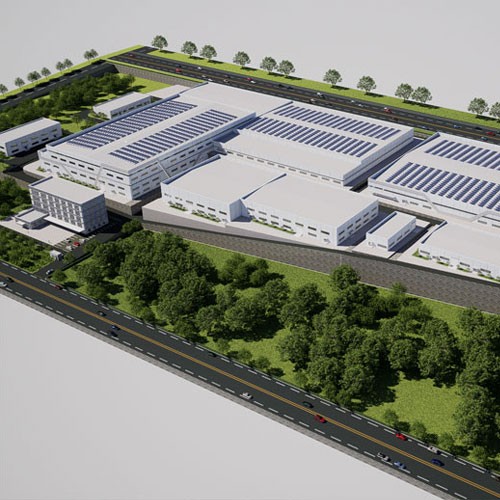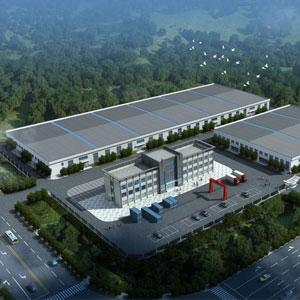Description
Heavy steel structure plays an extremely important role in the field of modern industrial construction and has gradually become the solid backbone of industrial buildings. The keywords of heavy steel structure, heavy steel plant and steel structure plant outline its wide application and excellent characteristics in industrial construction.
1. Conventional materials for heavy steel structure
Heavy steel structure usually uses high-strength steel, such as Q355B, Q390 and other materials. These steels have high yield strength and tensile strength and can withstand huge loads. In terms of component manufacturing, the main columns, beams and other components often use H-shaped steel, box columns or large steel pipes with larger cross-sectional dimensions. For example, for the columns of large heavy steel plants, wide flange H-shaped steel with a cross-sectional height of several meters may be selected to ensure that it has sufficient bearing capacity and stability. At the same time, high-strength bolt connection or welding process will be used at the connection parts. During welding, the relevant standards will be strictly followed to ensure the quality of the welds, so that the entire structure forms a stable whole, which is enough to cope with complex and harsh stress conditions.
2. Uses of heavy steel structures
Heavy steel plant is one of the main application forms of heavy steel structure, and is widely used in many heavy industrial fields. In the steel industry, it is used in large steelmaking workshops, rolling mills, etc. These workshops have huge steelmaking equipment, rolling mills, etc. Only heavy steel structure plants can provide sufficient space and carrying capacity. In the field of machinery manufacturing, such as large shipbuilding, heavy machinery processing and other plants, heavy steel structures are also used. For example, shipbuilding plants need to accommodate huge docks, lifting equipment and various large processing machine tools. Heavy steel structure plants can easily meet these needs, providing a solid and reliable space foundation for industrial production, and ensuring the smooth progress of large-scale, heavy industrial production.
3. Application environment of heavy steel structure
Heavy steel structure can show its strong adaptability in various harsh application environments. In high temperature environments, such as the furnace workshop in the metallurgical industry, although the surrounding temperature is extremely high, the heavy steel structure has undergone special heat-resistant design and protection treatment, which can maintain the stability of the structure and will not deform or reduce its strength due to high temperature. In coastal areas or chemical parks with high humidity, the use of anti-corrosion coatings, weathering steel and other measures can effectively resist the erosion of humid air, seawater and chemicals. In earthquake-prone areas, its good seismic performance is even more prominent. Due to the good ductility of steel, heavy steel structure plants can absorb and dissipate energy through their own deformation during earthquakes, reduce the damage to equipment and personnel in the plant, and ensure the continuity and safety of industrial production.
Fourth, the advantages of heavy steel structures
First, heavy steel structure plants have excellent bearing capacity. It can withstand great weight and complex load combinations, whether it is the dead weight of large mechanical equipment, or dynamic loads, wind loads, snow loads, etc. in the production process, it can easily cope with it, providing a stable and safe space environment for industrial production. Secondly, the spatial layout of heavy steel structures is highly flexible. Different spans, heights and plane layouts can be designed according to the needs of the production process, which is convenient for enterprises to carry out personalized production process planning and equipment layout. Moreover, its construction speed is relatively fast. Although the components are relatively heavy, due to the advancement of modern construction technology and equipment, after some components are prefabricated in the factory, they are assembled and installed on site, and the main structure can be built in a relatively short time. Compared with some traditional concrete structure factories, the construction period can be greatly shortened, allowing enterprises to put into production and operation faster, thereby saving time and cost and improving economic benefits. In addition, heavy steel structure factories also have advantages in terms of service life. After reasonable maintenance and care, their service life can be as long as decades or even longer, providing reliable fixed asset guarantees for the long-term development of enterprises.
1. Conventional materials for heavy steel structure
Heavy steel structure usually uses high-strength steel, such as Q355B, Q390 and other materials. These steels have high yield strength and tensile strength and can withstand huge loads. In terms of component manufacturing, the main columns, beams and other components often use H-shaped steel, box columns or large steel pipes with larger cross-sectional dimensions. For example, for the columns of large heavy steel plants, wide flange H-shaped steel with a cross-sectional height of several meters may be selected to ensure that it has sufficient bearing capacity and stability. At the same time, high-strength bolt connection or welding process will be used at the connection parts. During welding, the relevant standards will be strictly followed to ensure the quality of the welds, so that the entire structure forms a stable whole, which is enough to cope with complex and harsh stress conditions.
2. Uses of heavy steel structures
Heavy steel plant is one of the main application forms of heavy steel structure, and is widely used in many heavy industrial fields. In the steel industry, it is used in large steelmaking workshops, rolling mills, etc. These workshops have huge steelmaking equipment, rolling mills, etc. Only heavy steel structure plants can provide sufficient space and carrying capacity. In the field of machinery manufacturing, such as large shipbuilding, heavy machinery processing and other plants, heavy steel structures are also used. For example, shipbuilding plants need to accommodate huge docks, lifting equipment and various large processing machine tools. Heavy steel structure plants can easily meet these needs, providing a solid and reliable space foundation for industrial production, and ensuring the smooth progress of large-scale, heavy industrial production.
3. Application environment of heavy steel structure
Heavy steel structure can show its strong adaptability in various harsh application environments. In high temperature environments, such as the furnace workshop in the metallurgical industry, although the surrounding temperature is extremely high, the heavy steel structure has undergone special heat-resistant design and protection treatment, which can maintain the stability of the structure and will not deform or reduce its strength due to high temperature. In coastal areas or chemical parks with high humidity, the use of anti-corrosion coatings, weathering steel and other measures can effectively resist the erosion of humid air, seawater and chemicals. In earthquake-prone areas, its good seismic performance is even more prominent. Due to the good ductility of steel, heavy steel structure plants can absorb and dissipate energy through their own deformation during earthquakes, reduce the damage to equipment and personnel in the plant, and ensure the continuity and safety of industrial production.
Fourth, the advantages of heavy steel structures
First, heavy steel structure plants have excellent bearing capacity. It can withstand great weight and complex load combinations, whether it is the dead weight of large mechanical equipment, or dynamic loads, wind loads, snow loads, etc. in the production process, it can easily cope with it, providing a stable and safe space environment for industrial production. Secondly, the spatial layout of heavy steel structures is highly flexible. Different spans, heights and plane layouts can be designed according to the needs of the production process, which is convenient for enterprises to carry out personalized production process planning and equipment layout. Moreover, its construction speed is relatively fast. Although the components are relatively heavy, due to the advancement of modern construction technology and equipment, after some components are prefabricated in the factory, they are assembled and installed on site, and the main structure can be built in a relatively short time. Compared with some traditional concrete structure factories, the construction period can be greatly shortened, allowing enterprises to put into production and operation faster, thereby saving time and cost and improving economic benefits. In addition, heavy steel structure factories also have advantages in terms of service life. After reasonable maintenance and care, their service life can be as long as decades or even longer, providing reliable fixed asset guarantees for the long-term development of enterprises.
Heavy steel structure has become the first choice for heavy industrial factory construction with its strong bearing capacity, wide range of applications, good environmental adaptability and many advantages. It plays an irreplaceable and important role in the development of modern industry and lays a solid foundation for the efficient, stable and sustainable development of industrial production.










